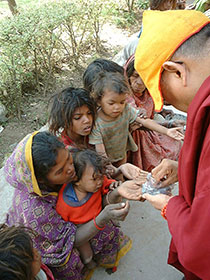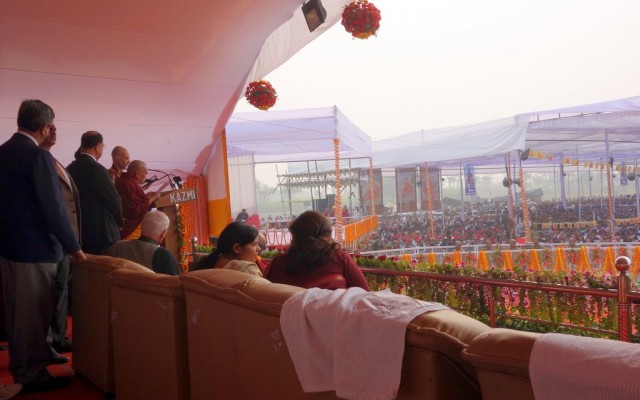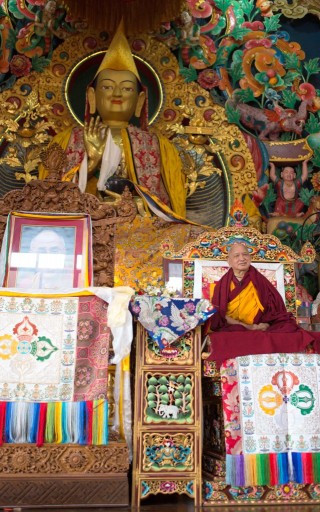- Home
- FPMT Homepage
Foundation for the Preservation of the Mahayana Tradition
The FPMT is an organization devoted to preserving and spreading Mahayana Buddhism worldwide by creating opportunities to listen, reflect, meditate, practice and actualize the unmistaken teachings of the Buddha and based on that experience spreading the Dharma to sentient beings. We provide integrated education through which people’s minds and hearts can be transformed into their highest potential for the benefit of others, inspired by an attitude of universal responsibility and service. We are committed to creating harmonious environments and helping all beings develop their full potential of infinite wisdom and compassion. Our organization is based on the Buddhist tradition of Lama Tsongkhapa of Tibet as taught to us by our founders Lama Thubten Yeshe and Lama Thubten Zopa Rinpoche.
- Willkommen
Die Stiftung zur Erhaltung der Mahayana Tradition (FPMT) ist eine Organisation, die sich weltweit für die Erhaltung und Verbreitung des Mahayana-Buddhismus einsetzt, indem sie Möglichkeiten schafft, den makellosen Lehren des Buddha zuzuhören, über sie zur reflektieren und zu meditieren und auf der Grundlage dieser Erfahrung das Dharma unter den Lebewesen zu verbreiten.
Wir bieten integrierte Schulungswege an, durch denen der Geist und das Herz der Menschen in ihr höchstes Potential verwandelt werden zum Wohl der anderen – inspiriert durch eine Haltung der universellen Verantwortung und dem Wunsch zu dienen. Wir haben uns verpflichtet, harmonische Umgebungen zu schaffen und allen Wesen zu helfen, ihr volles Potenzial unendlicher Weisheit und grenzenlosen Mitgefühls zu verwirklichen.
Unsere Organisation basiert auf der buddhistischen Tradition von Lama Tsongkhapa von Tibet, so wie sie uns von unseren Gründern Lama Thubten Yeshe und Lama Thubten Zopa Rinpoche gelehrt wird.
- Bienvenidos
La Fundación para la preservación de la tradición Mahayana (FPMT) es una organización que se dedica a preservar y difundir el budismo Mahayana en todo el mundo, creando oportunidades para escuchar, reflexionar, meditar, practicar y actualizar las enseñanzas inconfundibles de Buda y en base a esa experiencia difundir el Dharma a los seres.
Proporcionamos una educación integrada a través de la cual las mentes y los corazones de las personas se pueden transformar en su mayor potencial para el beneficio de los demás, inspirados por una actitud de responsabilidad y servicio universales. Estamos comprometidos a crear ambientes armoniosos y ayudar a todos los seres a desarrollar todo su potencial de infinita sabiduría y compasión.
Nuestra organización se basa en la tradición budista de Lama Tsongkhapa del Tíbet como nos lo enseñaron nuestros fundadores Lama Thubten Yeshe y Lama Zopa Rinpoche.
A continuación puede ver una lista de los centros y sus páginas web en su lengua preferida.
- Bienvenue
L’organisation de la FPMT a pour vocation la préservation et la diffusion du bouddhisme du mahayana dans le monde entier. Elle offre l’opportunité d’écouter, de réfléchir, de méditer, de pratiquer et de réaliser les enseignements excellents du Bouddha, pour ensuite transmettre le Dharma à tous les êtres. Nous proposons une formation intégrée grâce à laquelle le cœur et l’esprit de chacun peuvent accomplir leur potentiel le plus élevé pour le bien d’autrui, inspirés par le sens du service et une responsabilité universelle. Nous nous engageons à créer un environnement harmonieux et à aider tous les êtres à épanouir leur potentiel illimité de compassion et de sagesse. Notre organisation s’appuie sur la tradition guéloukpa de Lama Tsongkhapa du Tibet, telle qu’elle a été enseignée par nos fondateurs Lama Thoubtèn Yéshé et Lama Zopa Rinpoché.
Visitez le site de notre Editions Mahayana pour les traductions, conseils et nouvelles du Bureau international en français.
Voici une liste de centres et de leurs sites dans votre langue préférée
- Benvenuto
L’FPMT è un organizzazione il cui scopo è preservare e diffondere il Buddhismo Mahayana nel mondo, creando occasioni di ascolto, riflessione, meditazione e pratica dei perfetti insegnamenti del Buddha, al fine di attualizzare e diffondere il Dharma fra tutti gli esseri senzienti.
Offriamo un’educazione integrata, che può trasformare la mente e i cuori delle persone nel loro massimo potenziale, per il beneficio di tutti gli esseri, ispirati da un’attitudine di responsabilità universale e di servizio.
Il nostro obiettivo è quello di creare contesti armoniosi e aiutare tutti gli esseri a sviluppare in modo completo le proprie potenzialità di infinita saggezza e compassione.
La nostra organizzazione si basa sulla tradizione buddhista di Lama Tsongkhapa del Tibet, così come ci è stata insegnata dai nostri fondatori Lama Thubten Yeshe e Lama Zopa Rinpoche.
Di seguito potete trovare un elenco dei centri e dei loro siti nella lingua da voi prescelta.
- 欢迎 / 歡迎
简体中文
“护持大乘法脉基金会”( 英文简称:FPMT。全名:Foundation for the Preservation of the Mahayana Tradition) 是一个致力于护持和弘扬大乘佛法的国际佛教组织。我们提供听闻,思维,禅修,修行和实证佛陀无误教法的机会,以便让一切众生都能够享受佛法的指引和滋润。
我们全力创造和谐融洽的环境, 为人们提供解行并重的完整佛法教育,以便启发内在的环宇悲心及责任心,并开发内心所蕴藏的巨大潜能 — 无限的智慧与悲心 — 以便利益和服务一切有情。
FPMT的创办人是图腾耶喜喇嘛和喇嘛梭巴仁波切。我们所修习的是由两位上师所教导的,西藏喀巴大师的佛法传承。
繁體中文
護持大乘法脈基金會”( 英文簡稱:FPMT。全名:Found
ation for the Preservation of the Mahayana Tradition ) 是一個致力於護持和弘揚大乘佛法的國際佛教組織。我們提供聽聞, 思維,禪修,修行和實證佛陀無誤教法的機會,以便讓一切眾生都能 夠享受佛法的指引和滋潤。 我們全力創造和諧融洽的環境,
為人們提供解行並重的完整佛法教育,以便啟發內在的環宇悲心及責 任心,並開發內心所蘊藏的巨大潛能 — 無限的智慧與悲心 – – 以便利益和服務一切有情。 FPMT的創辦人是圖騰耶喜喇嘛和喇嘛梭巴仁波切。
我們所修習的是由兩位上師所教導的,西藏喀巴大師的佛法傳承。 察看道场信息:
- FPMT Homepage
- News/Media
-
- Study & Practice
-
-
- About FPMT Education Services
- Latest News
- Programs
- New to Buddhism?
- Buddhist Mind Science: Activating Your Potential
- Heart Advice for Death and Dying
- Discovering Buddhism
- Living in the Path
- Exploring Buddhism
- FPMT Basic Program
- FPMT Masters Program
- FPMT In-Depth Meditation Training
- Maitripa College
- Lotsawa Rinchen Zangpo Translator Program
- Universal Education for Compassion & Wisdom
- Online Learning Center
-
- Prayers & Practice Materials
- Overview of Prayers & Practices
- Full Catalogue of Prayers & Practice Materials
- Explore Popular Topics
- Benefiting Animals
- Chenrezig Resources
- Death & Dying Resources
- Lama Chopa (Guru Puja)
- Lama Zopa Rinpoche: Compendium of Precious Instructions
- Lama Zopa Rinpoche: Life Practice Advice
- Lama Zopa Rinpoche Practice Series
- Lamrim Resources
- Mantras
- Prayer Book Updates
- Purification Practices
- Sutras
- Thought Transformation (Lojong)
- Audio Materials
- Dharma Dates - Tibetan Calendar
- Translation Services
- Publishing Services
- Ways to Offer Support
- Prayers & Practice Materials
-
- Teachings and Advice
- Find Teachings and Advice
- Lama Zopa Rinpoche Advice Page
- Lama Zopa Rinpoche: Compendium of Precious Instructions
- Lama Zopa Rinpoche Video Teachings
- ༧སྐྱབས་རྗེ་བཟོད་པ་རིན་པོ་ཆེ་མཆོག་ནས་སྩལ་བའི་བཀའ་སློབ་བརྙན་འཕྲིན།
- Podcasts
- Lama Yeshe Wisdom Archive
- Buddhism FAQ
- Dharma for Young People
- Resources on Holy Objects
- Teachings and Advice
-
-
*If a menu item has a submenu clicking once will expand the menu clicking twice will open the page.
-
-
- Centers
-
- Teachers
-
- Projects
-
-
-
-
*If a menu item has a submenu clicking once will expand the menu clicking twice will open the page.
-
-
- FPMT
-
-
-
-
-
Our problem is that inside us there’s a mind going, ‘Impossible, impossible, impossible. I can’t, I can’t, I can’t.’ We have to banish that mind from this solar system. Anything is possible; everything is possible. Sometimes you feel that your dreams are impossible, but they’re not. Human beings have great potential; they can do anything. The power of the mind is incredible, limitless.
Manjushri Institute, 1977, Currently unpublished
Lama Yeshe Wisdom ArchiveLama Thubten Yeshe
-
-
-
- Shop
-
-
-
The Foundation Store is FPMT’s online shop and features a vast selection of Buddhist study and practice materials written or recommended by our lineage gurus. These items include homestudy programs, prayers and practices in PDF or eBook format, materials for children, and other resources to support practitioners.
Items displayed in the shop are made available for Dharma practice and educational purposes, and never for the purpose of profiting from their sale. Please read FPMT Foundation Store Policy Regarding Dharma Items for more information.
-
-
Mandala
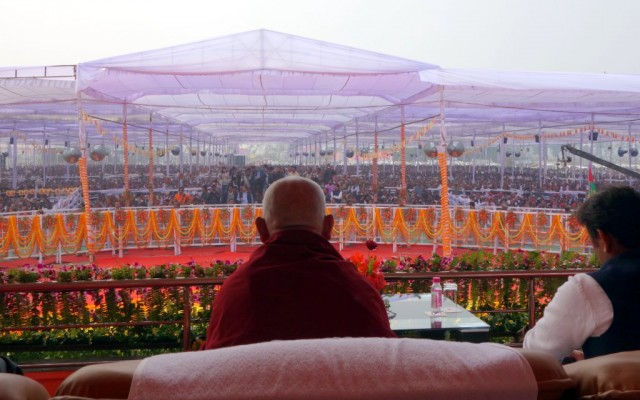
Lama Zopa Rinpoche and Akhilesh Yadav, Chief Minister of Uttar Pradesh, looking out over the crowd of 100,000, Kushinagar, Uttar Pradesh, India, December 13, 2013. Photo by Ven. Roger Kunsang.
The Uttar Pradesh State Government handed over a large segment of land to the Maitreya Project Trust on Friday, December 13, 2013, during a foundation stone laying ceremony. FPMT Spiritual Director Lama Zopa Rinpoche flew to the event in Kushinagar and with Akhilesh Yadav, the Chief Minister of Uttar Pradesh, addressed the crowd of 100,000 people. Several other important officials were there as well as the Maitreya Project Trust Board of Trustees.
The Maitreya Project will build one of the tallest statues of Maitreya Buddha on the land given by the Uttar Pradesh State Government. The Maitreya Project has worked with the state for more than decade to realized the building of the statue. Kushinagar is the historic site of Shakyamuni Buddha’s passing away. The Maitreya Project land sits adjacent to the Parnirvana Temple and Rambhar Stupa.
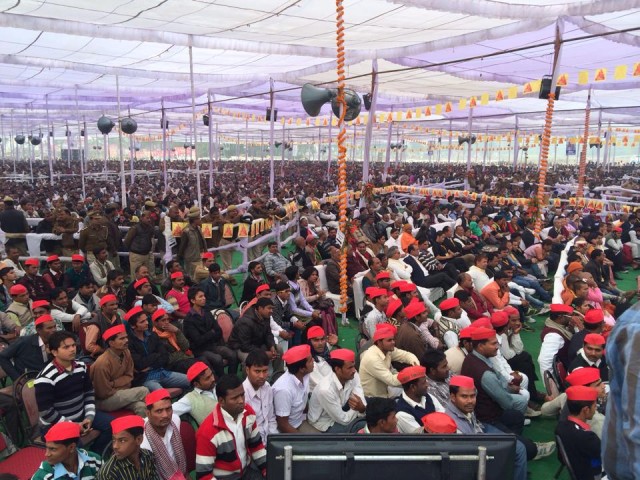
Thousands of people attended the foundation stone laying ceremony, Kushinagar, December 13, 2013. Photo by Ven. Sangpo Sherpa.
His Holiness the Dalai Lama sent a message that was read at the ceremony:
“I extend my greetings and best wishes to the Government and people of Uttar Pradesh.
“About 15 years ago, the Government of Uttar Pradesh approached me with a request that the Maitreya Project to construct a large statue of Maitreya Buddha come to Uttar Pradesh. I discussed this with Zopa Rinpoche and we agreed that Kushinagar would be the most favorable location for the statue.
“A long time has passed but I am happy to learn that the Government of Uttar Pradesh has kindly decided to provide land for the Maitreya Project to fulfill its purpose. I would like to express my gratitude to the Honorable Chief Minister and offer prayers for the success of the Maitreya Project – that it inspires peace, harmony, and goodwill throughout the entire world.
“I am grateful to the Maitreya Project and Zopa Rinpoche for undertaking this work. I understand that construction of a clinic to provide free medical services and the school will also be part of the larger project and therefore of additional benefits to the local people.”
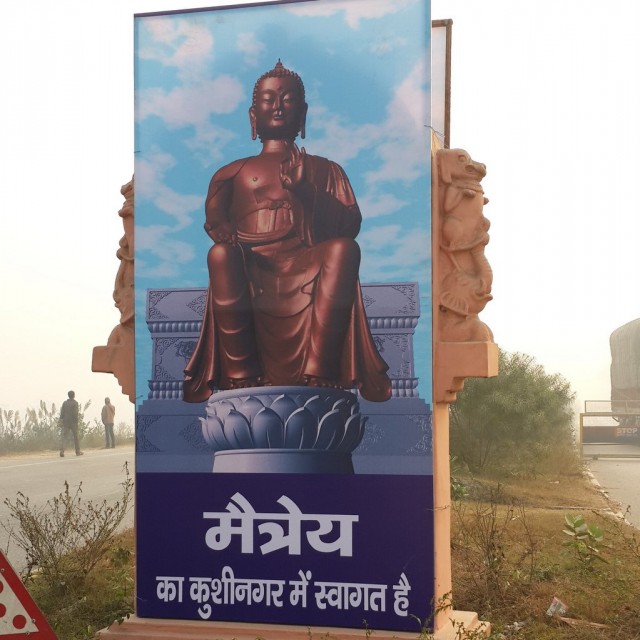
The future site of the Maitreya Buddha statue in Kushinagar, India, December 13, 2013. Photo by Atul Chopra.
The event also had a cultural program featuring a traditional Tibetan dance troupe from Dharamsala. Monks and nuns from Kopan Monastery, Root Institute staff and attendees from the recent Kopan course assisted hundreds of local workers with preparations for the event, which was put together with a week’s notice.
Read Mandala‘s coverage of the Maitreya Project, both recent stories and accounts of how the project has developed over three decades. For the official announcement, see the December 2013 Announcement from the Maitreya Project Kushinagar.
Mandala brings you news of Lama Zopa Rinpoche and of activities, teachings and events from over 160 FPMT centers, projects and services around the globe. If you like what you read on Mandala, consider becoming a Friend of FPMT, which supports our work.
- Tagged: kushinagar, lama zopa rinpoche, maitreya buddha project kushinagar, maitreya projects, mandala
- 0
13
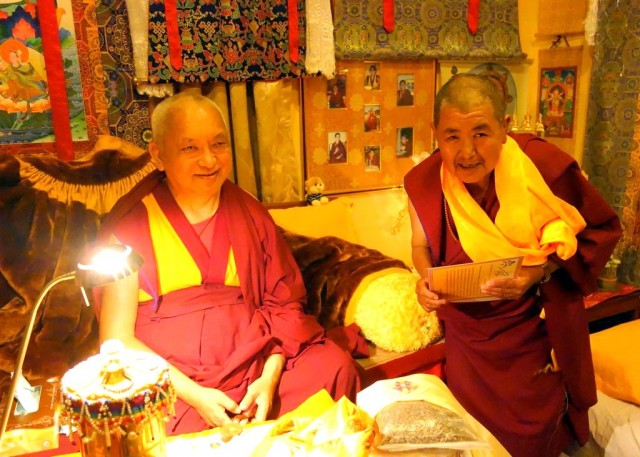
Lama Zopa Rinpoche and his sister Ani Ngawang Samten, Kopan Monastery, Nepal, November 2013. Photo by Ven. Roger Kunsang.
Lama Zopa Rinpoche’s older sister Ani Ngawang Samten visited with Rinpoche after his return to Kopan Monastery in November. Ani Samten came down to Kathmandu from Lawudo Retreat Centre, in the mountainous Solu Kumbu region of Nepal. Ven. Roger Kunsang, Rinpoche’s assistant, described Ani Samten as ”the ’mother’ of Lawudo. [She] looks after everything … except the recent building work which Rinpoche’s brother Sangay Sherpa does as the director.”
Lawudo is where Lama Zopa Rinpoche’s previous incarnation meditated. Ani Samten was key to the development and buidling of Lawudo Gompa and has taken care of the students, teachers and retreaters who have visited Lawudo since the early days of FPMT. Read more about her amazing contributions and work in the Mandala January-February 1998 article, “The Keeper of Lawudo.”
Learn more about FPMT spiritual director Lama Zopa Rinpoche and his beneficial activities by visiting Rinpoche’s homepage, where you will find links to Rinpoche’s schedule, new advice, recent video, photos and more.
- Tagged: ani ngawang samten, lama zopa rinpoche, lawudo, mandala
- 0
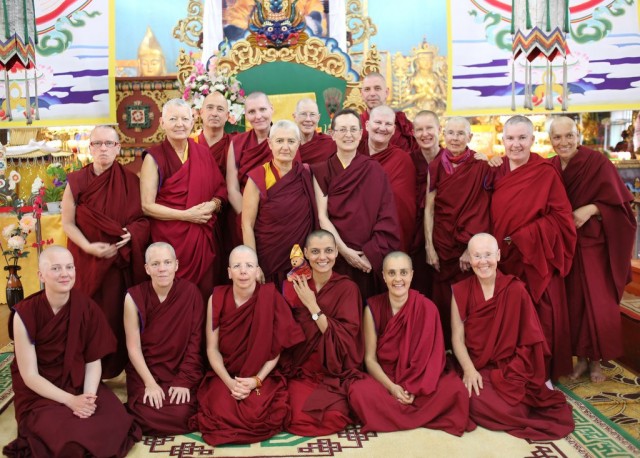
Western Sangha at 100 Million Mani Retreat in Mongolia, August 2013. Photo by Ven. Roger Kunsang.
The new issue of Mandala features a first-hand report from the historic 100 Million Mani Retreat in Mongolia held in August 2013 in Ulaanbaatar. Lama Zopa Rinpoche led the month-long retreat, which was hosted by FPMT Mongolia. As part of Mandala’s online edition, we’ve collected photos from the retreat into a photo gallery. Hundreds of Mongolians attended the retreat in addition to about 70 FPMT students and Sangha from Europe, Australia, Asia and North America.
Mandala brings you news of Lama Zopa Rinpoche and of activities, teachings and events from over 160 FPMT centers, projects and services around the globe. If you like what you read on Mandala, consider becoming a Friend of FPMT, which supports our work.
11
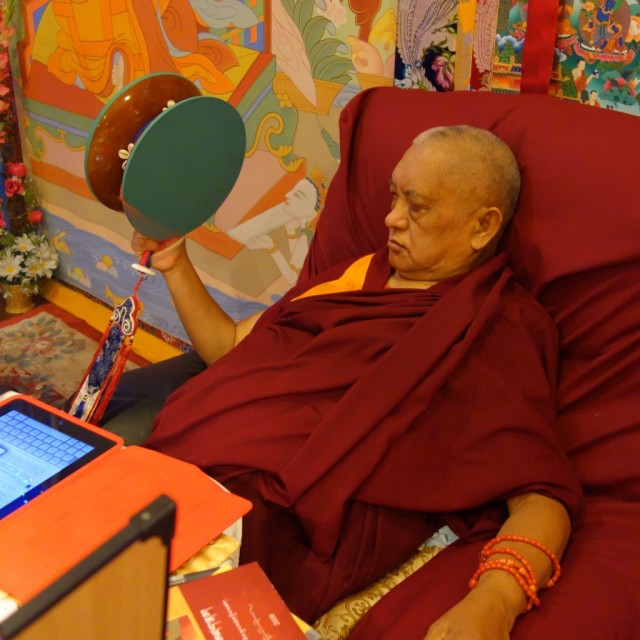
Lama Zopa Rinpoche playing a damaru, Kopan Monastery, Nepal, December 2, 2013. Photo by Ven. Roger Kunsang.
Ven. Roger Kunsang, Lama Zopa Rinpoche’s assistant and CEO of FPMT, shared that “Rinpoche [is] playing the damaru with his right hand. [It’s] a little difficult, but managing. The right leg and arm continue to improve.”
Rinpoche manifested a stroke in 2011, which affected his right arm and leg. His recovery continues to progress. Rinpoche is able to do many activities with his right arm and hand such as writing mantras and playing cymbals (and damaru) during puja.
VIDEO: Rinpoche playing cymbals
Learn more about FPMT spiritual director Lama Zopa Rinpoche and his beneficial activities by visiting Rinpoche’s homepage, where you will find links to Rinpoche’s schedule, new advice, recent video, photos and more. Visit “Rinpoche’s Health — Official Updates and Practices” to learn more and receive updates on Rinpoche’s health.
10
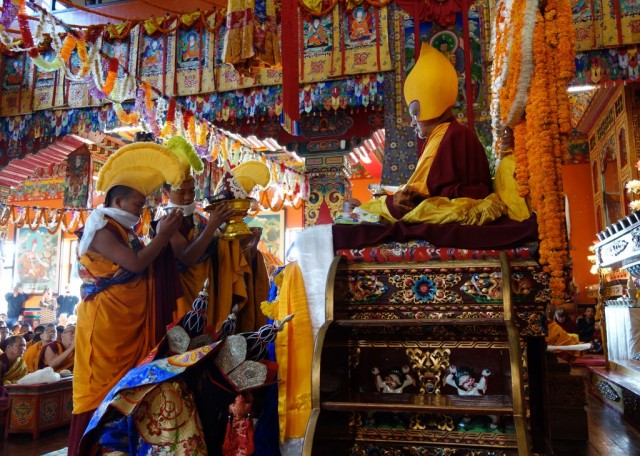
Tsog offering during long life puja with five dakinis for Lama Zopa Rinpoche, Kopan Monastery, Nepal, December 9, 2013. Photo by Ven. Roger Kunsang.
The annual long life puja for FPMT spiritual director Lama Zopa Rinpoche offered on behalf of FPMT centers, projects, services and students took place at Kopan Monastery in Nepal on December 9. Hundreds of people attended the puja, which took place at the end of the month-long meditation course at Kopan. Rinpoche was offered a total count of the prayers and practices done for Rinpoche’s health and long life.
More information, photos and updates about FPMT spiritual director Lama Zopa Rinpoche can be found on Rinpoche’s homepage. If you’d like to receive news of Lama Zopa Rinpoche via email, sign up to Lama Zopa Rinpoche News.
Each year FPMT offers a long life puja to Lama Zopa Rinpoche, you can learn more about long life pujas and how to support future pujas by visiting the Long Life Puja Fund page.
- Tagged: kopan course, kopan monastery, lama zopa rinpoche, long life puja, mandala
- 0
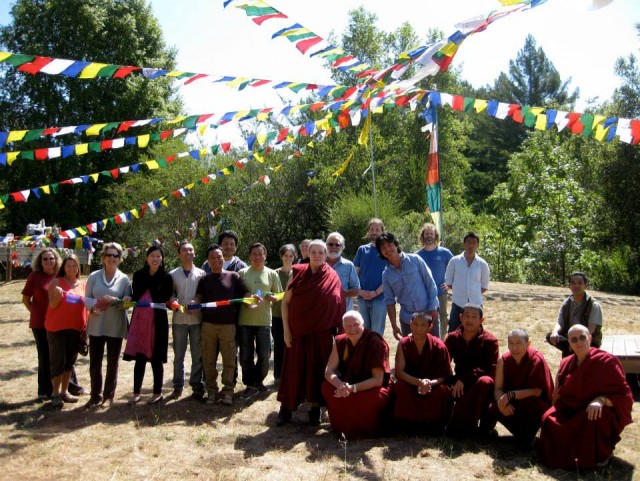
Land of Medicine Buddha community members after hanging new prayer flags, August 21, 2013. Photo courtesy of LMB’s Facebook page.
Special new prayer flags for Lama Zopa Rinpoche’s health and long life are flying and flapping in the breeze throughout the international FPMT mandala. Since July 2013, the Tendil Nyersel prayer flags are being hung based on advice given by Khadro-la (Rangjung Neljorma Khadro Namsel Drönme) on practices to remove obstacles for Rinpoche in 2014 and 2015. The flags feature an emanation of Guru Rinpoche (Padmasambhava) considered to be beneficial for Lama Zopa Rinpoche’s health, various prayers and mantras chosen by Rinpoche, and the supernatural animals of the cardinal directions. Kopan Monastery organized the making of the prayer flags, which was sponsored by a generous benefactor.
The newly released online content for the January-March 2014 issue of Mandala features a collection of photos from various FPMT centers, projects, services and students around the world that have hung flags to support Lama Zopa Rinpoche’s health and long life.
If you’d like to add a photo to the gallery, send Mandala an email.
Mandala brings you news of Lama Zopa Rinpoche and of activities, teachings and events from over 160 FPMT centers, projects and services around the globe. If you like what you read on Mandala, consider becoming a Friend of FPMT, which supports our work.
6
“Lama Zopa: We need to destroy our ignorance that grasps at true existence. Thru reasoning, understand the extensive kindness of living beings.”
– From Ven. Roger Kunsang’s Twitter page, posted on November 28, 2013
Ven. Roger Kunsang, Lama Zopa Rinpoche’s assistant and CEO of FPMT Inc., shares Lama Zopa Rinpoche’s recent pith sayings on Ven. Roger’s Twitter page. (You can also read them on Ven. Roger’s Facebook page.)
More information, photos and updates about FPMT spiritual director Lama Zopa Rinpoche can be found on Rinpoche’s homepage. If you’d like to receive news of Lama Zopa Rinpoche via email, sign up to Lama Zopa Rinpoche News.
- Tagged: kopan course, lama zopa rinpoche, twitter
- 0
6
Self-Inflatuation
By Ven. Chönyi Taylor
My brain loves playing with words which is why, one day, I read “self-infatuation” as “self-inflatuation.” Only a small change, but what possibilities my new word held. What a wonderful combination: flatulence and infatuation. Actually, I was reading about the Dalai Lama as reported by his cat.1 Now this cat may have misheard what His Holiness said, but I like the idea of self-inflatuation and it fits our Buddhist teachings very well.
Infatuation is “a foolish, unreasoning or extravagant passion or attraction.” That sounds very like our Buddhist definition of attachment and is closely related to addiction. It derives from the Latin infatuatus, meaning “to make a fool of.” An infatuated lover will do anything for the person they are attracted to and will regard this as dedication, passionate love, being totally for the other and without thought for oneself. Many women in abusive relationships stay there, they say, through the depth of their love. Hidden in this love is the thought, “I cannot leave this person because I am determined to hang on to the belief that he will, eventually, give me all I want.” We, looking from outside, know they are deluded, infatuated. They are out of touch with the reality of their predicament.
Self-infatuation is quite insidious. We also call it narcissism, a total absorption in an unrealistic and foolish view of oneself. We may be obsessed with a positive view, which means self-inflation or with a negative view, self-deflation. One child, when she was told she would get an award from school said, “But it can’t be me. I think they have made a mistake.” Often this self-infatuation is a belief about ourselves that we believe is absolutely true. I must be perfect, but I am not. I am clumsy. I can get my way through fighting. I am the brightest student in the class. My parents won’t love me if I don’t get a sports award. The belief is one thing. Obsessing about this belief is another.
In Buddhist terms, self-infatuation is ego-grasping – attachment – and attachment overvalues the wanted aspects of an object and ignores the unwanted aspects. Self-infatuation bloats our overriding self-importance. It is a view of self that goes well beyond the boundaries of reality. In the end, self-infatuation comes from the root ignorance behind all our suffering, believing we have an inherent existence. We are not immune from self-infatuation until we reach enlightenment.
In the film version of Charlie and the Chocolate Factory,2 when Charlie and his grandfather become inflated and have a merry time floating around, they have to burp to deflate themselves. Of course the other alternative, politely called “passing wind,” is not appropriate for a children’s book or film. Mind you, I think children would have a lot of fun with the alternative, but that is another story. We all know what flatulence is. How very picturesque this is: greed leads to an overfull digestive system which emerges in a very anti-social and smelly burst of wind. Self-inflation may feel like that, but is not quite the same, and it is very difficult to let it go. It is much more likely that it feels so good that we want more and more or it. We forget about its inevitable emergence in burps and farts.
In its extreme form, self-inflation is the manic part of bipolar depression. It can also be called arrogance, pomposity, the pride of thinking one is better than others when that in fact is not so. It demands to be fed but is never satisfied. No matter how many fawning acolytes one has collected, no matter how much wealth and power one has accumulated, it is never enough. It becomes dangerous and violent when the need for this pride to be fed dominates one’s whole mind. Compassion is seen as weakness. Nothing matters unless it feeds this voracious and expanding appetite. We can quickly create a list of people like this. They are among our politicians, media moguls, mining magnates, banking bullies, and cult leaders, found even in our tennis clubs and Dharma centers. Self-inflation is a damaging pride in which we think we are better than others when that is not true. Its dynamics we find in the Tibetan Wheel of Life when we look at the links of craving, grasping and attachment (addiction).
Of course, we think, this only applies to others. I do not believe I am Jesus Christ or Buddha. I do not believe that I am perfect.
Self-inflation can also mask as guru devotion. “I do more for my guru than anyone else, therefore I am more important.” Or, “I will be seen as being a better student than the others because I sit up straighter, meditate longer, know the details of ritual, donate more money or time (or whatever else you might add here) than any other student. And finally, “I, and I alone, am the backbone of this center.”
In putting infatuation and inflation together to create “self-inflatuation,” I mean a sense of self that is both bloated and obsessive. Self-inflatuated people can be the pillars of our communities, including our Dharma communities. They work SO hard. It is not what they do that causes problems, but the motivation behind it, puffing up the self, relying on the eight wordly dharmas.3 They delude themselves with the belief that the center exists through them and them alone and no one else is capable of keeping it together. They may not be the appointed director, but the appointed director absolutely must take their advice.
And if, perchance, you think that self-inflatuation would never apply to you, then think again. It is so easy to slip from a positive motivation into a self-inflatuated one. If you ever find yourself being upset because the work you have done was not recognized, or because your teacher seems to favor other students, or because you are upset about where you happen to sit in the teachings, then you have been caught up in self-inflatuation. In fact, any time we experience a negative emotion it is a sign of self-flatuation. As good Buddhists, we give ourselves a different title: I am being the best volunteer, or the biggest donor, or the smartest student, or the stickler for rules through my guru devotion, my dedication, and my passion for the teachings, never through my pride. I would be surprised if there was any Dharma student around who does not suffer from this blown-up state, at least sometimes, and that includes me. Since the definitive cure is enlightenment, we’d better get on with taking our medicine, the Buddhist path.
Ven. Chönyi Taylor is a registered Foundational Buddhism FPMT teacher and an elder for the Discovering Buddhism at Home Course. She is the author of Enough! A Buddhist Approach to Working with Addictive Patterns (Snow Lion, 2010) and has been published in Mandala, Buddhadharma, Dharma Vision and Sangha Magazine. She is a founding member and member of the training committee of the Australian Association of Buddhist Counsellors and Psychotherapists and an Honorary Lecturer in the Discipline of Psychiatry at Sydney University.
1. Michie, David (2012) Dalai Lama’s Cat, Hay House Visions
2. Dahl, Roald (1964) Charlie and the Chocolate Factory, Alfred A. Knopf, Inc
3. Being motivated by craving, pleasure, wealth, fame or praise on the one hand, or being terrified of pain, loss, disgrace, or blame on the other hand.
- Tagged: mandala, pride, ven. chonyi taylor
- 0
4
Jeffrey Hopkins Reconstructs His Mind
Jeffrey Hopkins, Buddhist scholar, Tibetan translator, author and professor of Buddhist Studies at the University of Virginia in the United States, suffered in 1991 from the debilitating and sometimes fatal Lyme disease. He talked to Ven. Robina Courtin in Kathmandu, Nepal in June 1993 about being close to death and of the experience of subtler states of mind.
Robina: When did you get sick, Jeffrey?
Jeffrey: I showed my sickness on March 17, 1991. I had for quite some time thought that something was wrong. I remember getting in my car at the university one day and thinking: “I’m not playing with a full deck!”
It was 10:30 in the morning. I had worked out with my friend and he was making breakfast. I was working on a book on colloquial Tibetan, which we have subsequently named Fluent Tibetan, but my problem was I wasn’t fluent! I was correcting something and trying to write the letter ya and I couldn’t write it. And I thought, “That’s strange.”
Then I went and lay down on my bed and suddenly the right side of my body was paralyzed. Even the right side of my tongue, which was amusing! It happens that, the night before, I had told my friend that if I ever got ill he should call Bill Magee, a student and friend of mine. I was in and out of the paralysis, so at some point I called out and said, “Call Bill! Now is the time!” At first he thought I was joking.
… On that first day they did a procedure to check whether my carotid artery was blocked; it wasn’t. They also did a spinal tap, which is that essentially they stick a shish kebab skewer into your spinal cord and withdraw fluid under a local anesthetic. It isn’t too painful if it is done well; I ended up having it done seven times, and one of them wasn’t done well and was painful for a few days.
You’re not supposed to have any white blood cells in the spinal fluid; if the count gets up to eleven, they feel that’s serious enough to be treated. My count was 144, which indicated a severe brain infection. They guessed encephalitis, so they began treating me with Cyclovir intravenously.
That first evening I was in the intensive care unit of the neurology section. For the most part I was floating in golden light.
Robina: Floating in golden light …
Jeffrey: It’s a reflex of a deeper experience, but with the deeper experience you don’t have the feeling of floating in something, you are the something. I did sometimes have an impression of a hospital, a little bit of surroundings, imagined. They talk about all appearances gradually disappearing at death …
From Mandala May-June 1995
- Tagged: mandala, your community
- 0
4
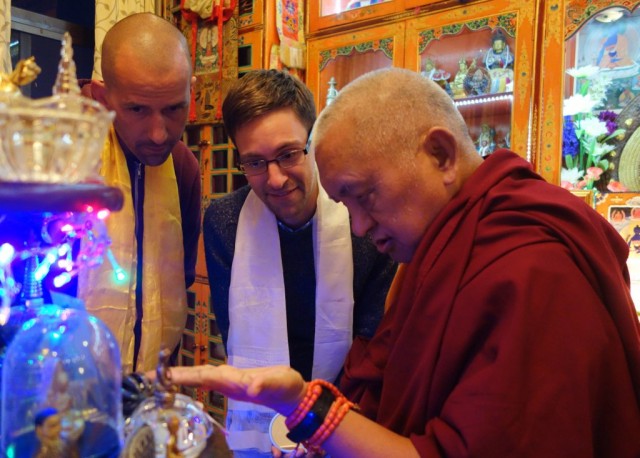
Lama Zopa Rinpoche pointing out the dorje of Padmasambhava to Tom Truty and friend, Kopan Monastery, Nepal, November 29, 2013. Photo by Ven. Roger Kunsang.
FPMT spiritual director Lama Zopa Rinpoche returned to Kopan Monastery on November 22. Since arriving, Rinpoche has offered teachings to students attending the month-long November course on lam-rim, circumambulated at Swayambhunath and received many visitors among other activities. FPMT Education Services director Tom Truty visited Rinpoche in late November. This is a particularly fruitful time for FPMT Education Services as Merry Colony, former director and who continues to work for the department, is also at Kopan, affording them all the opportunity to connect and discuss FPMT Education’s past and future.
FPMT Education Services materials are all produced under the guidance of Rinpoche. This includes practice books, education programs like Discovering Buddhism and Living in the Path, translations of important texts and much more.
Lama Zopa Rinpoche is the spiritual director of the Foundation for the Preservation of Mahayana Tradition (FPMT), an organization dedicated to preserving Mahayana Buddhism through offering the Buddha’s authentic teachings and to facilitating reflection, meditation, practice and the opportunity to actualize and directly experience the Buddha’s teachings. Sign up to receive news and updates.
- Tagged: fpmt education services, lama zopa rinpoche, tom truty
- 0
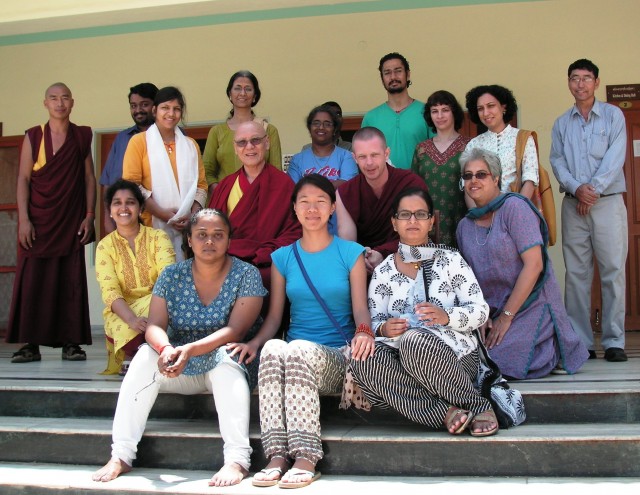
Students from Choe Khor Sum Ling received teachings from Gyume Monastery abbot Geshe Tashi Tsering (center in sunglasses), Hunsur, India, September 2013. Photo by Danyele Gringnon.
By Deepthy Shekhar
Student Deepthy Shekhar shares news from Choe Khor Sum Ling, the FPMT study group in Bangalore, India.
In September, a few Choe Khor Sum Ling students attended a retreat for Discovering Buddhism’s modules 1 and 2 at the glorious Snowland School for Tantric Studies at the Gyume Monastery campus in Hunsur, India. Ven. Tenzin Namdak led the retreat.
The main focus of this retreat was to engage in meditations on “Awakening One’s Enlightenment Potential.” The specific meditations were on the lam-rim topics of precious human rebirth, our innate potential to eliminate negative states of mind, buddhanature and on the topics of compassion and loving kindness.
All the participants were encouraged to take the Eight Mahayana Precepts and engage in Jorchö practices along with both analytical and single-pointed meditations around the topics mentioned above.
Following the tradition of Gyume Monastery, the participants had the precious opportunity of listening to Dharma teachings by the abbot of Gyume Monastery, Geshe Tashi Tsering, who gave two audiences. In the first teaching, Geshe-la spoke about habitual states of mind, inner and outer conditions, the law of cause and effect and purification with the four opponent powers.
In his second teaching, Geshe-la elaborated on the topic “Mind and Its Potential.” He spoke of considering Buddhist centers to be hospitals of the mind and of looking at the study of Buddhism as the study of inner science. During this teaching, he elaborated on topics such as mental factors, how to develop a main mind of loving kindness and developing the main mind for bodhichitta. He also spoke about the importance for meditating on emptiness as the antidote for grasping, anger and related mental factors.
During the retreat, participants were also encouraged to participate in tsog offerings and had discussions with each other in order to develop confidence in talking about their learning.
The students left fully immersed in precious human rebirth and Dharma teachings on mind and its potential, with aspirations for another retreat soon.
Mandala brings you news of Lama Zopa Rinpoche and of activities, teachings and events from over 160 FPMT centers, projects and services around the globe. If you like what you read on Mandala, consider becoming a Friend of FPMT, which supports our work.
- Tagged: choe khor sum ling, mandala
- 0
3
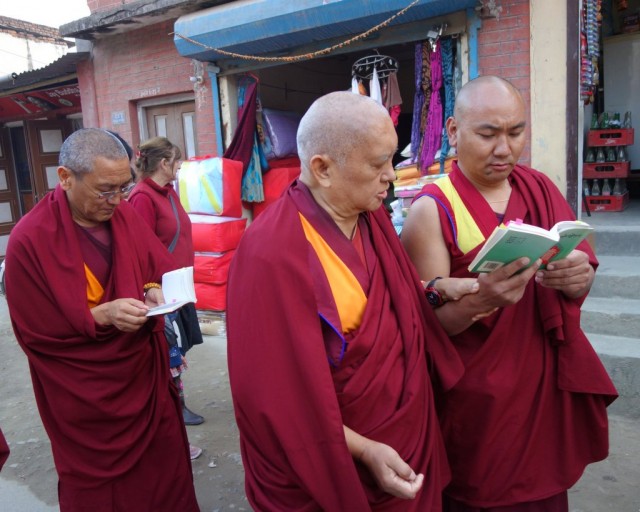
Lama Zopa Rinpoche with Khen Rinpoche Geshe Chonyi and others reading the Vajra Cutter Sutra while circumambulating at Swayambhunath Stupa, Nepal, November 24, 2013. Photo by Ven. Roger Kunsang.
“Lama Zopa: Your life has great meaning when you use this life to practice compassion.”
– From Ven. Roger Kunsang’s Twitter page, posted on November 28, 2013
Ven. Roger Kunsang, Lama Zopa Rinpoche’s assistant and CEO of FPMT Inc., shares Lama Zopa Rinpoche’s recent pith sayings on Ven. Roger’s Twitter page. (You can also read them on Ven. Roger’s Facebook page.)
More information, photos and updates about FPMT spiritual director Lama Zopa Rinpoche can be found on Rinpoche’s homepage. If you’d like to receive news of Lama Zopa Rinpoche via email, sign up to Lama Zopa Rinpoche News.
- Tagged: lama zopa rinpoche, swayambhunath, twitter
- 0
- Home
- News/Media
- Study & Practice
- About FPMT Education Services
- Latest News
- Programs
- New to Buddhism?
- Buddhist Mind Science: Activating Your Potential
- Heart Advice for Death and Dying
- Discovering Buddhism
- Living in the Path
- Exploring Buddhism
- FPMT Basic Program
- FPMT Masters Program
- FPMT In-Depth Meditation Training
- Maitripa College
- Lotsawa Rinchen Zangpo Translator Program
- Universal Education for Compassion & Wisdom
- Online Learning Center
- Prayers & Practice Materials
- Overview of Prayers & Practices
- Full Catalogue of Prayers & Practice Materials
- Explore Popular Topics
- Benefiting Animals
- Chenrezig Resources
- Death & Dying Resources
- Lama Chopa (Guru Puja)
- Lama Zopa Rinpoche: Compendium of Precious Instructions
- Lama Zopa Rinpoche: Life Practice Advice
- Lama Zopa Rinpoche Practice Series
- Lamrim Resources
- Mantras
- Prayer Book Updates
- Purification Practices
- Sutras
- Thought Transformation (Lojong)
- Audio Materials
- Dharma Dates – Tibetan Calendar
- Translation Services
- Publishing Services
- Teachings and Advice
- Find Teachings and Advice
- Lama Zopa Rinpoche Advice Page
- Lama Zopa Rinpoche: Compendium of Precious Instructions
- Lama Zopa Rinpoche Video Teachings
- ༧སྐྱབས་རྗེ་བཟོད་པ་རིན་པོ་ཆེ་མཆོག་ནས་སྩལ་བའི་བཀའ་སློབ་བརྙན་འཕྲིན།
- Podcasts
- Lama Yeshe Wisdom Archive
- Buddhism FAQ
- Dharma for Young People
- Resources on Holy Objects
- Ways to Offer Support
- Centers
- Affiliates Area
- Teachers
- Projects
- Charitable Projects
- Make a Donation
- Applying for Grants
- News about Projects
- Other Projects within FPMT
- Support International Office
- Projects Photo Galleries
- Give Where Most Needed
- FPMT
- Shop
Subscribe to FPMT News
Translate*
*powered by Google TranslateTranslation of pages on fpmt.org is performed by Google Translate, a third party service which FPMT has no control over. The service provides automated computer translations that are only an approximation of the websites' original content. The translations should not be considered exact and only used as a rough guide.If you listen to the advice of the Buddha – who has only compassion for sentient beings and no trace of self-centred mind; who is perfect in power, wisdom and compassion; whose holy mind is omniscient – all you get is benefit.







